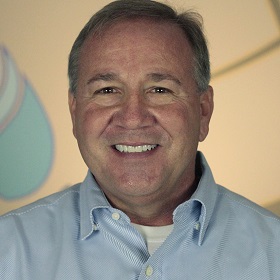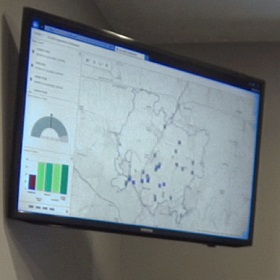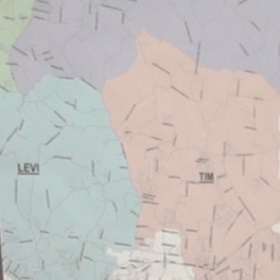Bill Thompson was anguishing over an ever-deepening problem that threatened the ability of one of Tennessee’s largest water providers to effectively serve its customers.
As general manager of the White House Utility District (WHUD) just north of Nashville, Thompson had always prided himself on being a practical executive—one who didn’t blindly follow the latest trends or conventional wisdom. He saw himself as a leader open to change and one who wanted employees to be empowered to make decisions without relying on layers of supervisors.
But he wasn’t just open to change; Thompson had always tried to anticipate change. In 1992, when geographic information systems (GIS) were a rarity in the water industry, Thompson recognized the potential of the technology and began the implementation of GIS. He hoped the location-based system—in conjunction with the customer information system (CIS) that governed WHUD’s day-to-day operations and billing—would give his workforce the information and confidence they needed to make decisions.
That’s when Thompson realized that the issue was not simply managing the growth—it was how WHUD was managing the growth. Technology had become a hindrance. The tools intended to empower employees were instead creating roadblocks, holding them back. So he did what he had done so many times before. He began exploring innovative ways to solve the problem by thinking outside industry norms.
Thompson researched new CIS platforms and held discovery sessions with vendors, seeking a solution that would help the utility district manage the growth it was facing. Thompson quickly found that none sufficed. The type of solution he had envisioned was not available.
“I kind of got ill about the whole thing,” Thompson says. Still, he kept turning the problem over in his mind.
Then, suddenly, the fog cleared.
Iconoclastic Insights Spur Company-Wide Change
Thompson had two insights that would change the dynamics of the organization.
First, he realized that despite his hopes for sharing data across departmental lines, WHUD had developed silos of information. The text-based CIS billing software was on one side and the map-based GIS—containing information about the location and status of pipes, pumps, personnel, and other assets—was on the other side. Information exchange between the two systems rarely happened. Employees tried to work around the issue, but their instinct to solve problems was stymied by a lack of connectivity and communication.
“The systems have to be working for the people, not the people working for the systems,” Thompson says. “You don’t want to hear, ‘We can’t do this because the system won’t allow it.’”

Organizational change management . . . requires leadership dedication, involvement of employees at all levels, and constant communication. Transformational change is strategy-driven and stems from the top of the organization.
The problem was affecting everything, starting with the utility district’s ability to effectively manage growth, and extending to how it served customers. Thompson knew that the WHUD representative answering a customer’s phone call was the face of the organization. “The person you get on the phone—that’s the only person you know. That’s the person who should be able to solve any service question or issue. In most instances, however, the customer service department is so detached from other parts of the organization they can’t make decisions.” As a result, employees felt limited in their ability to help customers and make decisions.
“Our GIS and our CIS were basically incompatible,” Thompson says. “That meant you had to extract data out of one, analyze it, then use it to make a decision over in another. And by the time we did that, we lost a lot of time and frustrated too many customers and employees.”
His second insight emerged when he looked at the system from the customer service point of view.
“All of our employees need real-time information about the operating conditions occurring in the system, as well as the physical location of our field crews,” Thompson says. “And then it hit me: we’re really going about this backwards. Everything we do is location based and asset based, so it only made sense that GIS should lead the way. It should be the driving force.”
Going against the Grain Yields Huge Gains in Efficiency and Savings
For most utilities, the customer information system is the dominant database—whether user-friendly or not. But customer service reps need to know more than the current billing status to solve most problems. They should see a map of the customer’s location with details of its maintenance and repair history, as well as the location of field service reps in the area and when they will finish current appointments.
Field technicians and other personnel, who had been waiting hours for information before attacking potential problems, would be able to gather relevant data on equipment status and maintenance history in minutes. New leak detection software would integrate with the GIS maps, helping the utility discover small leaks and quickly fix them before they grew into large problems.
It took about three years to create and implement the user-friendly, GIS-centric system. Business executives who have overseen an enterprise software implementation understand the demands of such a transformation: sound planning, patience, and a dedication to change management.
For Thompson, WHUD, and the communities they serve, the effort paid off handsomely. With the new technology in place, WHUD no longer needed to consider an urgent overhaul of the physical assets or the issuance of debt in reaction to the growing population. That bond has been postponed for at least 11 years. Interest payments on it would have topped $6 million during the same period. Perhaps more important, through the integration of these systems, WHUD gained data continuity across the organization, which enabled Thompson and team to perform more-proactive strategic planning.
Preparing the Workforce for Change
As WHUD planned for the overhaul of technology and business processes, Thompson knew there would be many concerns among WHUD’s 100 employees. Would they have a job? What if they didn’t have the right skills? What if they couldn’t learn quickly enough?

Long term, if a business isn’t agile, and that includes the water business, if it’s not flexible and can’t adapt quickly, then you become antiquated, and you’re effectively dead.
It was a moment when rumors could lead to low morale and further inefficiency, and that could be disastrous for a utility providing vital services. Thompson, however, had complete faith in WHUD’s team and was guided by the same goal he had always held dear. “I wanted to give everybody . . . as much information as they needed to do their job and be their own decision-maker.”
As he prepared a change management strategy and training program, he showed an intuitive feel for the major points that professionals recommend: prepare for change; manage change; reinforce it. And be honest with employees.
As the implementation of the GIS-based system approached, he offered his team reassurance. “We’re going to change the way we operate,” Thompson told employees. “If you need education, if you need to get your skills shored up—whatever you need—we’re going to help you get there. But we need you to understand we are going to do this, and we’re going to turn this around in a different direction.”
Employees knew the system had become inefficient. Still, they worried about the changes.
Tammy Moses, who is a field operations assistant (roughly equivalent to a customer service rep) with 13 years at WHUD, wondered if a new system meant new barriers. Would it be timely, user-friendly, and help her satisfy customers? “Is it going to take me longer to do my job in an account?”
Levi Wyatt, a field technician supervisor (similar to a supervisor of work crews in the field) with five years at WHUD, was concerned about the new software. “How much time was it going to add to our workflow?” he wondered. “The field tech position can be hectic, with little time to waste.”
In keeping with change management strategies, Thompson repeated the message: We must change; I must change. But we will help you.
(Learn more about the impact of change management on organizations.)
Shifting the Workplace Culture
Thompson had gone through other implementations; he saw what resistance and confusion did to the atmosphere. To fend it off, he and the executive team prepared extensively and over-communicated. For two years, in nearly every monthly meeting, he talked about it. “By the time we were ready to implement, employees were tired of hearing me talk; they were excited to get under way with it.”

In the water business, even though a lot of times there’s only one provider, the fact of the matter is that we should still strive to provide the same exceptional service that any other industry provides.
As the technology overhaul got under way and the effort to change the workplace culture began to become more formalized, Thompson followed a key tenet of successful change: include stakeholders from all areas of the business in planning new workflows. He formed a committee that included representation from every department in the organization, regardless of how much or how little the transition would impact their work processes.
Some of those employees became coaches and informal counselors, who assured their fellow employees that the training was to strengthen skills and not to spot weaknesses for which they would be punished.
As they figured out the best way to build the new system, Thompson sought feedback from those who would rely on it daily. “If it doesn’t feel right or isn’t working,” he said, “tell us and let’s figure out what’s wrong with it, because it needs to be what’s best for you, not what I think, or the consultants think, is best.”
Field supervisor Levi Wyatt was impressed by the GIS trainers. “The team was patient and made sure to really understand what information we needed or wanted to see. They even did a ride-along in the field to make sure everything was operating smooth.”
Wyatt also liked the gradual way the message of change became part of their daily lives. His own message to workers facing similar changes in their organization: “The learning curve and the extra time and effort put into this will greatly benefit all of us, and our customers, in the long run.”
Change Management and ROI
Studies have shown that the more successfully a company manages change, the faster the return on investment in new technology or software. ROI of 135 percent is not uncommon with a good change management program.
The most important elements of success are engaged executives and senior leaders who remain visible, vocal, and accessible throughout the process, according to studies by Prosci, a change management consulting firm. And Thompson was nothing if not engaged—but he also displayed empathy that his employees valued.
“If we were ever feeling overwhelmed, Bill always told us to hit the pause button and step away from it for a little bit if need be,” said operations manager Rocky Reecer.
Thompson put it even more bluntly. “I told all of our people, ‘Look, you’re going to get frustrated, you may get mad. You know what? I probably am too, but you can come in my office and get it off your chest and it’s not going to bother me. You’re not going to get fired. We’re going to push, but we’re not going to push in a way that you can’t reach your potential.’”
And, of course, even motivated employees will learn at different paces and in different ways. If one individual was having difficulty, WHUD managers would hold a group training session and use it as a way to quietly give that person individual attention. Even though it could mean more expense on the front end, Thompson thought it was the right thing and the practical thing to do. With success would come more efficiency, a more closely bonded team, and a grateful workforce.
“They were good enough for us to hire,” Thompson says. “They ought to be good enough to invest in.”
In bottom-line terms, Prosci research shows that potentially disruptive projects paired with a people-focused change management plan are up to six times more likely to achieve their goals.
Working in the New System
Placing GIS and location intelligence at the center of every employee’s workflow has produced dramatic changes at WHUD.
Reecer, who has worked for the utility district for 15 years, was very happy to see the new GIS produce more accurate maps.
“It has been nice to go out into the field with your iPad and be able to stand directly over something and it be right at your feet. An improved GIS has taken out a lot of the searching and potholing, and we have become more efficient.”
That efficiency has allowed managers to allocate more time to leak detection, an effort that has saved the utility hundreds of thousands of dollars per year.

From a change management standpoint, I have always been the type of person that if it’s new or it’s better, we’re going to do it. We’re going to figure out how to do something the best way possible for the business and our customers.
And the GIS-dominant system has tapped the power of location intelligence in new ways at WHUD, according to Thompson. “We have all our vehicles tracked in real time via GIS, so the customer service reps [CSR] can see who’s the nearest if they need to dispatch somebody.”
When a customer calls WHUD now, the CSR taking the call sees the customer’s data on one screen and a GIS-based map of the customer’s location on a second screen. In other words, the silos of information are gone—replaced by real-time location intelligence.
“Everything I need to see about the customer’s meter and box locations, layout of property, our water and sewer lines is now at my fingertips,” says CSR Tammy Moses.
Lessons Learned—Change Never Ends
It took more than three years to implement the new systems and work processes, as well as finish the retraining of WHUD’s 100 employees.
As difficult as it was to face change and as happy as Thompson was to close this chapter, he knows the effort should not be set aside.
“It’s important to go through every single process,” Thompson says. “And when you finish doing that, you need to go back and revisit it about every two years because things will change, people change, and you need those processes documented so you know what’s going on.”
And when there are new changes to manage, he advises: “Be completely honest and not hide anything. Let them know what the goal is right from the very beginning. Because if a business isn’t agile—and that includes the water business—if it’s not flexible and can’t adapt quickly, then you become antiquated, and you’re effectively dead.”
For more on the human factors involved in change management, listen to this podcast.
The Esri Brief
Trending insights from WhereNext and other leading publicationsTrending articles

December 5, 2024 |

July 25, 2023 |

November 12, 2018 |

February 1, 2022 |

July 29, 2025 |

July 14, 2025 |






